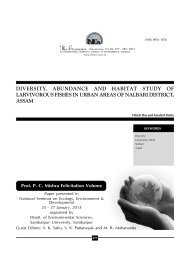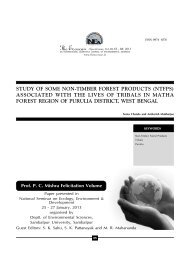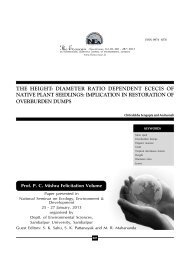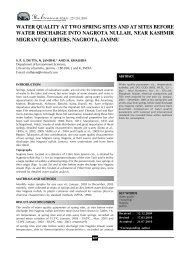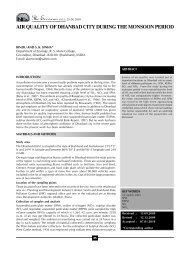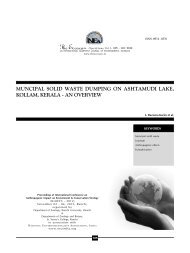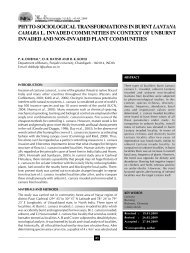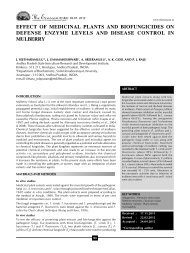Tripti Bouri.pmd - An International Quarterly Journal of ...
Tripti Bouri.pmd - An International Quarterly Journal of ...
Tripti Bouri.pmd - An International Quarterly Journal of ...
Create successful ePaper yourself
Turn your PDF publications into a flip-book with our unique Google optimized e-Paper software.
NSave Nature to Survive<br />
QUARTERLY<br />
TRIPTI BOURI* AND AMBARISH MUKHERJEE<br />
Centre for Advanced Study, Department <strong>of</strong> Botany,<br />
University <strong>of</strong> Burdwan, Burdwan - 713 104, West Bengal, INDIA<br />
E-mail: tbouribot@gmail.com<br />
ABSTRACT<br />
The present study documents the non timber<br />
forest products used by the tribal people <strong>of</strong><br />
Basudha beat <strong>of</strong> Durgapur Forest Range under<br />
Burdwan District, West Bengal. The local<br />
people mainly belong to Santhal communities.<br />
Their activities include collection <strong>of</strong> different<br />
non-timber items <strong>of</strong> forest resources and<br />
cultivation. This work records 131 plant species<br />
<strong>of</strong> angiosperms belonging to 60 family and<br />
118 genera. The taxonomic analysis shows<br />
that the dicot and monocot ratio is 114:17.<br />
Habit analysis shows that the herb: shrub:<br />
climber: tree composes the forest in the ratio<br />
<strong>of</strong> 29: 27: 16: 59 respectively. A precise account<br />
<strong>of</strong> their habit, common name and use category<br />
has been prepared which as a document might<br />
prove useful in stock-taking <strong>of</strong> biodiversity and<br />
their conservation through sustainable use.<br />
INTRODUCTION<br />
Forests around the world provide a massive variety <strong>of</strong> valuable products aside<br />
from the timber we use. Non-Timber Forest Products (NTFP) are defined as anything<br />
that is harvested or collected from forests that are not trees to be cut into timber.<br />
This includes a large variety <strong>of</strong> foods, medicines, fuel, forage, plants used for dye,<br />
and much more. The forest dwellers mainly belong to tribal communities and<br />
they mainly depend on forest flora for their livelihood. Some NTFPs are highly<br />
valuable in local and global markets. For exhaustible involvement <strong>of</strong> non timber<br />
forest products in commercial sphere directly from the forests as very valuable<br />
commodities, many species have been perceiving threat <strong>of</strong> extinction and<br />
necessitating immediate conservation and protection. In view <strong>of</strong> the importance<br />
<strong>of</strong> the non-timber forest products and their implications with forest conservation<br />
and livelihood <strong>of</strong> forest dwellers the present work was undertaken in the forested<br />
areas <strong>of</strong> Basudha Beat in Durgapur Forest Range <strong>of</strong> Burdwan district, West Bengal.<br />
MATERIALS AND METHODS<br />
Ethnobotanical surveys were carried out since 2009 in the forested areas <strong>of</strong><br />
Basudha beat under Durgapur Forest Range <strong>of</strong> Burdwan District to collect the<br />
primary data pertaining to phytoresources more or less following the standard<br />
methods (Rao, 1989). Pertinent plant specimens were collected which were<br />
processed for herbarium preservation as voucher specimens for future references<br />
as well as for identification using authentic literature (Prain, 1903; Guha-Bakshi,<br />
1984; Bennet, 1987). The voucher specimens have been preserved in the<br />
Herbarium <strong>of</strong> the Ecotaxonomy Laboratory <strong>of</strong> the Department <strong>of</strong> Botany, Burdwan<br />
University.<br />
Study site<br />
Basudha beat is located at 23º26’’N L and 87º27’’ E L under Kanksa Block <strong>of</strong><br />
Durgapur forest range <strong>of</strong> Burdwan District. This beat is located between the rivers<br />
Ajoy in the north and Kunur in the south. The local people are mainly Santhals<br />
and dependent on non-timber forest products for their livelihood (<strong>Bouri</strong> and<br />
Mukherjee, 2011; Mukherjee and <strong>Bouri</strong>, 2011). Their dependence on NTFPs is<br />
very high especially during subdued agricultural production. The soil is lateritic<br />
in nature. <strong>An</strong>nual rainfall is 1500 mm.<br />
RESULTS<br />
This work records 131 plant species <strong>of</strong> angiosperms (Table 1) belonging to 60<br />
families and 118 genera. The taxonomic analysis shows that the dicot and monocot<br />
ratio is 114:17 (Fig. 1). Habit analysis shows that the herb: shrub: climber: tree<br />
composes the forest in the ratio <strong>of</strong> 29: 27: 16: 59 respectively (Fig. 2).<br />
*Corresponding author<br />
DISCUSSION<br />
During an ethnobotanical study in Basudha beat <strong>of</strong> Durgapur Forest Range<br />
70





